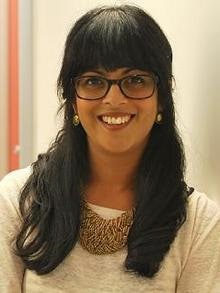The Institute for Higher Education Policy (IHEP) announced a new two-year research initiative in partnership with the University of Iowa Liberal Arts Beyond Bars (UI LABB) program and Moreau College Initiative (MCI) that will focus on higher-education prison programs and their impact on recidivism rates.
According to IHEP’s issue brief, “Unlocking Potential: Results of a National Survey of Post-secondary Education in State Prisons,” nearly seven in 10 people who are formerly incarcerated will commit a new crime, and half will end up back in prison within three years.
 Dr. Julie Ajinkya
Dr. Julie AjinkyaThe UI LABB program works with the University of Iowa to provide education to men in the Iowa Medical and Classification Center. Since the program is new, UI LABB can put the earned credits only on an Iowa transcript. However, within the next year, they hope to partner with a local community college that will allow them to offer associate’s and bachelor’s degrees.
“I think the general media impression of higher education in prisons is about reducing recidivism, which is the government argument,” said Kathrina Litchfield, director of UI LABB. “It does that but it does many other things, as well. And the hope of this partnership with IHEP is to explore and provide some empirical and qualitative data that shows the other benefits that come with that opportunity.”
MCI is a collaboration between Holy Cross College and the University of Notre Dame and is run similarly to the two main campuses. The MCI classes are taught by Holy Cross and Notre Dame faculty at Westville correctional facility, and this year 35 classes were offered.
“We are going to use the research initiative to build a better data management system and provide more extensive support for our students so that we can follow them more closely and also provide greater assistance with reentry,” said Dr. Alesha D. Seroczynski, director of college operations for the Westville Education Initiative. “So, anywhere from additional education, finding affordable housing and employment services they might need [such as] resume-writing workshops to budgeting.”
With support from the Great Lakes Higher Education Corporation and Affiliates, IHEP, alongside practitioners, will develop a set of metrics to implement in the prison education programs. When the metrics framework has been reviewed by other researchers, UI LABB and MCI will use it in their teachings.
“The goal for this research initiative is to really assess the impact of post-secondary opportunities that are offered to incarcerated students,” said Dr. Julie Ajinkya, IHEP’s vice president of applied research. “Thus far, folks have focused on some research, including ours, that tell us that educational opportunities help reduce recidivism upon release.”
There are around 200 credit-bearing programs that offer post-secondary coursework, taught in person by professors in prisons across the United States, according to Ajinkya. These programs allow prisoners to gain college credit for their classes and earn a degree while incarcerated.
“There are very different types of programs, different types of coursework offered, different delivery methods of learning in the classroom, and so it’s a really diverse space which is just even more reason why we want to research,” said Ajinkya.
IHEP’s research will target adult students who are incarcerated in state institutions. Their goal is to see if the programs allow the prisoners to further their education, earn good jobs and become civically engaged leaders within their community following release from prison.
“We really want to figure out which programs are helping students reenter to be the strongest participants in their community as possible,” said Ajinkya.
In 1994, Pell grants were banned for incarcerated students and soon after, many states banned their funding, as well. In addition, many institutions or programs are requiring their students to cover their own tuition – making tuition affordability a major challenge, according to Ajinkya.
However, UI Labb’s tuition is free, as it is covered by the university president’s office. In addition, MCI is one of 67 sites chosen to be in the Second Chance Pell program. The program allows eligible prisoners to receive Pell grants for help with tuition fees.
IHEP’s focus on incarcerated students goes back almost 25 years, when IHEP became one of the first groups to contribute seminal research to the field as the discussion of banning Pell Grants for incarcerated students occurred, according to Ajinkya.
“We have a long history in this space, and we are now hoping to build on this path and really offer important data-driven research that would encourage robust standards of practice in these programs,” said Ajinkya.
Most recently, in 2017, IHEP released a social media campaign, #CollegeNotPrison, which focused on the story of Alton Pitre, who was incarnated in Los Angeles for two years. Through the higher education prison programs, Pitre is now only a few credits away from graduating Morehouse College.
“When you think about the racial injustice in the criminal justice system in this country, it becomes clear that students who have been underserved historically are disproportionally involved in the criminal justice system,” said Ajinkya. “So we really think that the transformative power of higher education can not only improve these students’ lives but can fundamentally disrupt the injustice of the criminal justice system right now.”
Sarah Wood can be reached at [email protected].





















